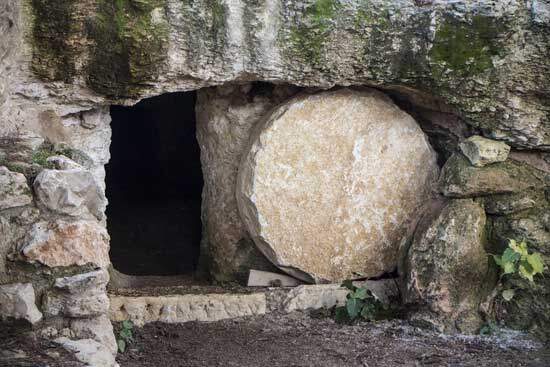Jesus Christ, a person who lived in first-century Palestine, is the foundation of the Adventist faith. This is because it’s only through the life, death, and resurrection of Jesus that any of us have hope of life beyond the toil, suffering, and death of this world.
When evil first entered our world, God promised to send a Messiah who would overcome evil and restore us to a perfect world once again (Genesis 3:15).
While on earth, Jesus, the promised Son of God, made that possible and showed us who God really is.
This post will go over the significance of the various stages of Jesus’ life and ministry:
Here is the Adventist Church’s official statement on this topic:
“In Christ’s life of perfect obedience to God’s will, His suffering, death, and resurrection, God provided the only means of atonement for human sin, so that those who by faith accept this atonement may have eternal life, and the whole creation may better understand the infinite and holy love of the Creator.
This perfect atonement vindicates the righteousness of God’s law and the graciousness of His character; for it, both condemns our sin and provides for our forgiveness. The death of Christ is substitutionary and expiatory, reconciling, and transforming. The bodily resurrection of Christ proclaims God’s triumph over the forces of evil, and those who accept the atonement assures their final victory over sin and death.
It declares the Lordship of Jesus Christ, before whom every knee in heaven and on earth will bow.”
Let’s break this down as we look at each aspect of the life of Jesus.
Why is Jesus Christ so important?

Photo by FRANK MERIÑO
Jesus, who is part of the Godhead with the Father and the Holy Spirit, willingly came to this earth to show us who God is and save us from the destructive consequences of sin and evil. Through His life, He was our example; through His death, our substitute; and through His resurrection, our restoration.
To really understand the significance of the life of Christ, we have to go back to the Old Testament.
God placed the first humans in a perfect paradise. He wanted a real relationship with them, which meant that He had to give them freedom of choice (Genesis 2:16–17).
Sadly, they chose to distrust God and gain a knowledge of evil and sin. They believed the devil’s lies about God (Genesis 3:1–6).
Sin and evil can’t exist with a God of love (1 John 4:8), but He had a plan to rebuild His relationship with humans—a way that humans could be freed from sin and live by His law of love again.
God promised to send a Messiah (or deliverer) to fulfill that plan (Genesis 3:15).
Jesus came to the earth as a human to show us who God was and demonstrate His love (John 1:14). He lived as a human being, encountering the same limits, frustrations, and temptations as we do. By His life, He taught us how to overcome through God’s help.
And He died, taking the consequences of all our sins so that we can have eternal life with Him.
As astonishing as it is that He chose to do this, what’s even more astonishing is that He chose to do it because He loved us.
A well-known verse in the Gospel of John tells us:
“For God so loved the world that He gave His only begotten Son, that whoever believes in Him should not perish but have everlasting life” (John 3:16, NKJV).
So, how did that love shine out? What was the life of Jesus like?
Jesus’ birth and childhood
Other than the birth of Jesus, God’s Word doesn’t reveal many details about His early years. Here’s what we do know.
His birth itself was a miracle—He was born from a virgin

Photo by Pro Church Media on Unsplash
Before Jesus’ birth, an angel appeared to His human mother, a Jewish woman named Mary, and told her she would bear a son (Luke 1:28–33). She responded,
“How can this be, since I do not know a man?” (Luke 1:34, NKJV).
The child in Mary’s womb was the result of the Holy Spirit’s miraculous power (Matthew 1:20).
He was born in unassuming circumstances
While Jesus’ parents, Joseph and Mary, were traveling due to a census in the Roman Empire, Mary became ready to give birth. Unable to find a place to stay in Bethlehem, they had to camp in a dirty stable.
And that’s where Jesus was born (Luke 2:7).
A small feeding manger was His first bed. Simple rags were His first clothes—something our nativity scenes only give us a small glimpse of!
His parents fled with Him to Egypt as refugees
When Jesus was only a toddler, he received some unique visitors: wealthy men from the east, or “wise men.”
After seeing a strange star in the sky and reading the prophecies about the Messiah in the Hebrew Scriptures (Matthew 2:2), these wise men had come to Jerusalem looking for Jesus. Their inquiries, however, made their way to King Herod, who was angry at the thought of a rival to his throne.
Determined to squelch any insurrection, King Herod tried to have Jesus killed, but angels warned Joseph in a dream and instructed him to flee with Mary and Jesus to Egypt (Matthew 2:13–18).
They remained as refugees in Egypt until the death of Herod.
He grew up in a small working-class town
When Jesus and his parents returned from Egypt, they were finally able to settle in Nazareth (Matthew 2:19–23).
In the time of Jesus, Nazareth was likely a small village or town in the region of Galilee in Israel. And from the remark of Nathanael (who became a disciple of Jesus), we can deduce that it was not an area viewed favorably by the Jews:
“Philip found Nathanael and told him, ‘We have found the one Moses wrote about in the Law, and about whom the prophets also wrote—Jesus of Nazareth, the son of Joseph.’
‘Nazareth! Can anything good come from Nazareth?’ Nathanael asked'” (NKJV).
He learned the family trade of carpentry

Photo by Clem Onojeghuo
Joseph must have been known as a carpenter in Nazareth since references in the Gospels recognized Jesus as the “carpenter’s son” and a carpenter Himself (Matthew 13:54–55; Mark 6:3).
Up until age 30, He earned His living and helped His family by the work of His hands and the sweat of His brow. He showed that even the common trades and most mundane jobs have value and can be avenues for reflecting God’s love.
He was sinless
All through His growing up years, “Jesus increased in wisdom and stature, and in favor with God and men” (Luke 2:52, NKJV).
Together with other Christians, Adventists believe Jesus never sinned, not even as a child.
Hebrews 4:15 tells us:
“For we do not have a high priest who is unable to sympathize with our weaknesses, but one who has been tempted in every way as we are, yet without sin” (CSB).
He experienced life and faced the struggles and temptations we do. But through them all, He held onto His Father and chose not to sin.
Thus, even as a child, Jesus must have been quite different from other children.
We see His uniqueness when He visited Jerusalem for the Jewish Passover feast at the age of 12.
After the feast, His parents left Him behind in Jerusalem, not realizing He wasn’t with them. When they returned for Him three days later, they found Him among the religious scholars, asking them questions and astonishing them with His knowledge (Luke 2:46–47).
“Why were you searching for Me?” He asked Joseph and Mary. “Didn’t you know that it was necessary for Me to be in My Father’s house?” (Luke 2:49, CSB)
Already, He understood the calling God had for Him.
But though Jesus knew the purpose He’d been born for, He patiently waited on God’s timing.
The Bible picks up with the story when He begins His ministry at the age of 30.
Jesus’ public ministry
Jesus’ life and ministry are a fulfillment of the Old Testament prophecies concerning the coming Messiah.1
And He was not just a Messiah for Israel but for the whole world (John 3:16–17; Romans 5:18).
Let’s take a look at how that ministry began.
He was baptized as our example
Jesus’ ministry began when He left His carpenter’s workbench at Nazareth and headed to the Jordan River.
There, John the Baptist, His cousin, had been preaching and baptizing people in preparation for the Messiah.
Jesus approached Him, asking to be baptized as an example for us.
After John had immersed Jesus in the water and brought Him back up, “the heavens suddenly opened for Him, and he saw the Spirit of God descending like a dove and coming down on Him. And a voice from heaven said, ‘This is My beloved Son, with whom I am well-pleased’” (Matthew 3:16–17, CSB).
These words and the Holy Spirit symbolized by the dove confirmed Jesus’ identity and mission (Acts 10:38).
He taught, preached, and healed

Photo by FRANK MERIÑO
All four of the Gospels—Matthew, Mark, Luke, and John—spend a great deal of time writing about Jesus’ ministry, which lasted three and a half years. He had a threefold ministry, as pointed out in Matthew 4:23:
1. Teaching
2. Preaching
3. Healing
The things Jesus taught and preached fill the New Testament. His words were simple and practical, yet profound. He taught with authority—as someone who knew God personally and understood the Jewish Scriptures (Matthew 7:28–29).
At the same time, Jesus’ teachings were relatable to the people. Many of His parables borrowed from the daily experiences of His listeners, such as tending sheep, sweeping a home, or farming.
As Jesus expressed in his famous Sermon on the Mount, His purpose was to uphold the principles of God’s law and character of love (Matthew 5:17, 43–48). He showed what true kingdom living was like while stripping away the useless religious rituals of His time (Matthew 23).
During His ministry, Jesus also performed many miracles—turning water into wine at a wedding (John 2:1–11), feeding the 5,000 (John 6), raising Lazarus to life (John 11), and healing one of the high priest’s servants who came to arrest Him (Luke 22:49–51), to name a few.
He was constantly ministering to the hurt, the broken, and the suffering:
“Wherever He entered, into villages, cities, or the country, they laid the sick in the marketplaces and begged Him that they might just touch the hem of His garment” (Mark 6:56, NKJV).
“And as many as touched Him were made well” (Luke 5:15, NKJV).
In all of these activities, Jesus had twelve men—disciples—who went with Him (Matthew 10:1). He did life together with them and taught them to reach out to people as He did (Mark 3:14).
He lifted the burden of sin
Jesus did more than heal physically. He healed hearts and minds that had been burdened and broken by sin.
He befriended the outcasts of society—those considered hopeless sinners. And He showed them their value and set them free to live new lives (Luke 15:1–2; John 8:1–11).
Mary Magdalene was one of those individuals. Jesus cast seven demons out of her, and as a result, she became one of Jesus’ closest followers (Mark 16:9).
All of what Jesus did was possible because of what He would accomplish at the end of His ministry: He would die in our place, taking on the consequences of sin so we don’t have to and demonstrating the ultimate act of love (John 15:13).
He said this about His mission:
“The Son of Man must suffer many things, and be rejected by the elders and chief priests and scribes, and be killed, and be raised the third day” (Luke 9:22, NKJV).
The next section will help us understand the significance of what He did for us.
Jesus’ death

Photo by Ismael Paramo on Unsplash
All four of the Gospels depict the death of Jesus— a central part of God’s plan of salvation and restoration.
Jesus was betrayed by His disciple Judas, arrested secretly by a Jewish mob, and tried in unjust trials in the middle of the night. Finally, He was condemned by the Roman official, Pontius Pilate, to the death of a criminal—crucifixion.
But the physical pain wasn’t the worst of it—Jesus suffered the agony of bearing the guilt of humanity’s sins and the resulting separation from His Father.
He died the death we deserved
Christ died as our substitute, taking upon Himself our sins, or violations of His law.
All of us human beings fall short of God’s law—the Ten Commandments (Romans 3:23).
But that law isn’t just some arbitrary set of dos and don’ts. It is a reflection of God’s character of love, showing us how healthy relationships with God and others function (Matthew 22:38–40).
The penalty for breaking that law is death (Romans 6:23). But again, that penalty isn’t arbitrary. It’s the natural consequence of living selfishly rather than out of love for God and others.
Left to our own resources, we would plunge deeper and deeper into selfish living. Eventually, the only thing left for us would be destruction and death.
But God, in the person of Jesus, took upon Himself the punishment for our sins. He carried our sins and showed us how far love is willing to go to ensure we’re not lost forever.
It’s Jesus saying, “Take Me instead.”
In fact, He did just that when, the night before His death, He went to the Garden of Gethsemane to pray. Already, He was feeling the weight of sin upon Himself, causing Him to sweat drops of blood (Luke 22:44).
He agonized:
“O My Father, if it is possible, let this cup pass from Me; nevertheless, not as I will, but as You will” (Matthew 26:39, NKJV).
Though our sins would crush Him, He accepted His Father’s will and went forward with His plan.
He bore our sin
Jesus took the condemnation we deserve. His perfect life of love stands in place of our selfishness and sinfulness (2 Corinthians 5:21).
An account in the Old Testament illustrates this.
When the children of Israel had committed a terrible sin against God, Moses stood before God and said to Him:
“Yet now, if You will forgive their sin—but if not, I pray, blot me out of Your book which You have written” (Exodus 32:32, NKJV).
The Hebrew word for “forgive” is nasa, a word used hundreds of times in the Hebrew Bible to mean “to bear, to lift, to carry.”
The text could have just as easily been translated, “Yet now, if You will bear their sin.”
The very idea of God forgiving sin means God Himself bears and carries it:
“Surely He has borne our griefs and carried our sorrows” (Isaiah 53:4, NKJV).
The word for “borne” there is nasa. So when we look at Jesus on the cross, we see God taking upon Himself the suffering and punishment for the sins of the whole world so that everyone in the world, no matter who they are, could have eternal life.
He saves us even though we don’t deserve it

Photo by @felipepelaquim on Unsplash
Have you ever felt too sinful, or too evil, to be accepted?
That’s precisely why Christ died for us.
He died for all of us so that we might be forgiven and accepted despite our sins and despite the seemingly unforgivable things we have done—things we can barely seem to forgive ourselves for as well:
“But God demonstrates His own love toward us, in that while we were still sinners, Christ died for us” (Romans 5:8, NKJV).
Not while we were goody-two-shoes.
Not while we were obeying God’s law.
No. But while we were still sinners, Christ died for us.
Perhaps nothing illustrates the reality of the gospel better than the story of the thief on the cross.
Jesus was crucified with two thieves. They were criminals who deserved their punishment, unlike Jesus.
At first, both thieves taunted and mocked Jesus (Matthew 27:44).
But one of the thieves had a change of heart and cried out:
“Lord, remember me when You come into Your kingdom” (Luke 23:42, NKJV).
And what did Jesus say?
Jesus didn’t throw this criminal’s sinful past in his face. Jesus didn’t point out all the reasons the thief didn’t deserve salvation—though there were plenty.
Instead, Jesus looked at this man—a sinner, a man with many faults, a man who had nothing to offer, a man who had lived contrary to God’s law of love.
And without hesitation, He said to him, “You will be with Me in paradise” (Luke 23:43, NKJV).
And the same is true for us. Jesus’ death is fully and freely offered for our sins. All we have to do is accept it.
But here’s the thing—because Jesus hadn’t violated the law of love, death couldn’t hold Him (Acts 2:22). Resurrection was the only option.
Jesus’ resurrection
Jesus’ life and death for us would have been all for nothing if He had not risen from the dead (on a day we sometimes call Easter). His resurrection was the crowning act while here on this earth, bringing together His work for us. Together, His life, death, and resurrection provide for our salvation and restoration.
When writing to the church at Corinth, the apostle Paul emphasized how central Jesus’ death was to his teachings:
“For I determined not to know anything among you except Jesus Christ and Him crucified” (1 Corinthians 2:2, NKJV).
However, in the same letter, Paul says something astonishing:
“And if Christ has not risen, then our preaching is empty and your faith is also empty…. And if Christ has not risen, your faith is futile; you are still in your sins! Then also those who have fallen asleep in Christ have perished” (1 Corinthians 15:14, NKJV; 1 Corinthians 15:17–18, NKJV).
Because of the resurrection, Christ triumphed over death and destroyed the power that it has over those who choose Christ:
“For He must reign till He has put all enemies under His feet. The last enemy that will be destroyed is death” (1 Corinthians 15:25–26, NKJV).
Furthermore, Christ’s resurrection and subsequent ascension to heaven allow us to look forward to His return when He’ll raise His followers from the dead (1 Thessalonians 4:16–17).
Someday, we’ll live in a world free from death:
“And God will wipe away every tear from their eyes; there shall be no more death, nor sorrow, nor crying. There shall be no more pain, for the former things have passed away” (Revelation 21:4, NKJV, emphasis added).
But as good as it sounds, did the resurrection really happen? Is there any evidence?
How do we know Jesus rose from the dead?
The resurrection, prophesied and attested to in the Bible, is not only a religious teaching. Evidence points to it being a historical event.
First, the Bible has been shown to be historically accurate when compared with archeological evidence, geography, and the writings of other historians of the time, even non-Christian ones.
And the Bible contains many accounts of the resurrection: All four Gospel writers, though writing from different times, places, and perspectives, talked about it. Paul discussed it over and over in his letters.
Other biblical writers also referred to Christ’s resurrection (Acts 1:3; Romans 8:34; 1 Peter 1:21; Revelation 1:5).
Beyond that, we have historical evidence that Jesus Christ was crucified by the Romans.2 But the question is, What happened afterward?
Did Jesus really rise from the dead?
There are only two other options:
1. Jesus didn’t die.
2. Jesus didn’t rise; His body was stolen, and His disciples made up the story of His resurrection.
An Adventist apologist, Subodh K. Pandit, who has researched, spoken, and written on this topic, walks through these two theories. Here’s a summary of the points he makes in his book:3
Evidence Jesus did die
- Pontius Pilate, the historical figure who ordered the death of Jesus,4 made sure that Jesus was dead (Mark 15:44–45).
- The Roman soldiers, individuals trained in killing, pierced Jesus’ side to make sure He was dead (John 19:33–35).
- If Jesus hadn’t died, it would have been nearly impossible for Him to unwrap His graveclothes, roll away the stone of His tomb, and leave—all while weakened from beatings, loss of blood, and not having eaten. He wouldn’t have been able to escape the notice of the Roman guards.
Evidence that Jesus’ body was not stolen
- The guards were paid to say that Jesus’ disciples stole His body while the guards slept (Matthew 28:13). But this report was inconsistent. If the guards were asleep, how did they know Jesus’ disciples stole His body?
- The Roman soldiers had been placed at the tomb for the very specific purpose of preventing anyone from stealing Jesus’ body (Matthew 27:64). It’s not likely that they all would’ve been off their guard at once.
- The disciples didn’t stand a chance against the Roman guards. It would’ve been very difficult for them to open the tomb without being noticed.
- The folded grave clothes were left in the tomb (John 20:7). If Jesus’ disciples had stolen His body, they probably wouldn’t have folded the clothes in their rush. In fact, they probably wouldn’t have removed them at all.
- The disciples didn’t have a reason to take Jesus’ body. They were hiding in fear and didn’t think Jesus would rise from the dead (John 20:9, 19).
Evidence for the resurrection
- Many people were eyewitnesses of Jesus after His resurrection.5
- It changed the disciples from cowardly and fearful (John 20:19) to bold proclaimers of Jesus (Acts 2; Acts 4:13), even at the cost of their lives.
- It resulted in the powerful movement of the early Christian church, as recorded in the Acts of the Apostles.
- Saul of Tarsus, a fierce opponent of Jesus and the early church, became one of Jesus’ most ardent followers, eventually dying for his beliefs.6
- None of the followers of Jesus made deathbed confessions admitting they were wrong. Why would they have died for the sake of a tall tale?
All this evidence points to the wonderful truth of the life, death, and resurrection of Jesus, which gives us hope for eternity.
Jesus’ life sets an example and gives us hope
Jesus’ life sets us an example of how we can live with love by depending on God.
His death paid the ultimate price for our sins. Even the sins that we commit when we miss following His perfect example.
And finally, His resurrection provides us with the chance to choose Him. By choosing Him, we receive the assurance and power to overcome sin (John 1:12) and the promise of complete restoration:
“Therefore we were buried with Him through baptism into death, that just as Christ was raised from the dead by the glory of the Father, even so we also should walk in newness of life” (Romans 6:4, NKJV).
To learn how you can have that life with Christ,
Choose an Online Bible Study
Want to keep learning? Find out more about Jesus, humanity, the plan of salvation, and how God loves you enough to sacrifice everything, just to give you a chance to choose Him.
Sometimes it can be hard to know where to start, that’s why we offer free, user-friendly, online Bible study options you can do anytime, anywhere, and at your own pace.
This online Bible school will take you through the major themes of Scripture, breaking down the Bible’s complex concepts into bite-sized pieces, which can lead you toward the answers of life’s more challenging questions.
- Genesis 3:15; Micah 5:2; Isaiah 7:14; Daniel 9:24–27; Psalm 41:9; Isaiah 53; Psalm 22:7–8, 18. [↵]
- Gathercole, Simon, “What Is the Historical Evidence that Jesus Christ Lived and Died?” The Guardian, April 14, 2017. [↵]
- Pandit, Subodh, Come Search With Me, Book 2: The Weight of Evidence, pp. 80–96. [↵]
- “Archaeologists Find First Evidence of Existence of Pontius Pilate,” Jewish Telegraphic Agency. [↵]
- Luke 1:1–3; John 19:35; Acts 10:40–41; 1 Peter 1:16; 1 John 1:1. [↵]
- Wallace, Jimmy, “How the Life of Paul Makes the Case for Christianity,” Cold-Case Christianity, Dec. 6, 2021. [↵]
Related Articles
More Answers
Adventist Beliefs
Learn how the 28 Fundamental Beliefs summarize and describe Seventh-day Adventism. They are not a checklist of requirements; instead they show how Adventists interpret and apply Scripture.
What Do Adventists Believe About the Authority of the Bible?
Learn how one really old book (the Bible) is the sole foundation for all Seventh-day Adventist beliefs.
Is the Soul Immortal? Exploring What Adventists Believe
Based on the way the Bible describes humanity in comparison to God and angels, Seventh-day Adventists believe souls are not something you have, but something you are.
What Do Adventists Believe About the Mark of the Beast and 666?
It’s a popular topic, especially during tumultuous times. When everything around you feels chaotic, it’s easy to wonder about the end of the world, and topics like the mark of the beast, as mentioned in Revelation 13, can stir up uneasiness.
What Do Adventists Believe About the Atonement?
If you’ve spent much time in the Bible books of Leviticus or Numbers, you might’ve noticed the word atonement.
Do Seventh-day Adventists Believe Only They Will Go to Heaven?
No, Adventists definitely don’t believe they’re the only ones that will go to heaven. As a matter of fact, we don’t believe admittance into heaven is ever based on which church or denomination we belong to. People all over the world from different Christian denominations, religions, and walks of life will be welcomed by Jesus.
How Adventists Developed the Sanctuary Doctrine and What It Means
The sanctuary was a building at the center of ancient Israelite society that gives us a small picture of the original sanctuary, God’s throne room in heaven (Hebrews 8:1-2).
What Do Adventists Believe About Faith and Works?
Adventists believe we are saved by faith, which is the belief and trust we have in Jesus to save us from our sins. Jesus, then, enables us to live in harmony with God’s commandments and serve others with love—sometimes referred to as “works.”
Do Seventh-day Adventists Believe in Hell?
Seventh-day Adventists believe that any human being who accepts God’s free gift of salvation through Jesus will be given eternal life. But what about the eternal fate of those who choose not to accept Jesus?
Sola Scriptura—What It Means and Why It Matters
Sola scriptura is a term that originated during the Protestant Reformation. It represents the way many Christians view the Bible and its authority. While the idea is simple enough, there is so much more to sola scriptura than its basic definition.
Do Seventh-day Adventists Believe in the Secret Rapture
The secret rapture belief asserts that the followers of Jesus will be suddenly and stealthily “raptured” from earth and taken to heaven. Then, any people left on earth will face a period of great difficulty—before Christ’s second coming actually happens.
Why do Adventists Emphasize Religious Liberty?
Adventists see religious liberty as an essential human right. After all, God endowed humanity with freedom of choice from the very beginning. So we believe it’s best for governments to also support their citizens’ rights to worship based on their convictions.
What Seventh-day Adventists Believe About Growing in Christ
Christian growth is the experience of allowing Jesus Christ to work in our lives through the Holy Spirit and restore in us the image we were designed for—God’s image of selfless, other-centered love.
What Do Seventh-day Adventists Believe about the New Earth?
Seventh-day Adventist, like other Christians, believe that after the second coming of Christ, God will cleanse our earth by fire and then restore it back to Eden-like perfection.
What Adventists Believe About the Millennium and the End of Sin
As most Christians, Seventh-day Adventists hope for the time when sin and evil will no longer exist. The Bible teaches that God will bring an end to sin after a thousand-year period of time called the millennium.
What Are Seventh-day Adventists Beliefs on Death and the Resurrection?
The thought of dying can seem scary. And the idea of being resurrected—or coming back to life—can seem a little uncomfortable.
What Do Seventh-day Adventists Believe about The Second Coming of Christ?
The second coming of Jesus Christ is an event the Bible prophesies will occur at the end of this world’s history. It’s called His second coming to distinguish it from His first, when Jesus was born to Mary and lived as a human before dying on the Cross.
What Adventists Believe About Jesus’ Ministry in the Heavenly Sanctuary
The ancient Israelite sanctuary had a daily service and a yearly service. Jesus’ death on the Cross and His ministry in the heavenly sanctuary reflect these services.
What do Seventh-day Adventists Believe about Marriage and Family?
The Seventh-day Adventist Church believes God established marriage and the family unit to be blessings to humanity. They make up a relational structure that can reflect the multifaceted nature of God’s love.
What Seventh-day Adventists Believe about Christian Behavior
The patterns of actions and words that make up behavior are central to any type of belief system because they flow from those beliefs. Seventh-day Adventists look to the Bible, with Jesus as the perfect example, for guidance on shaping our daily behavior.
What do Seventh-day Adventists Believe about the Sabbath?
Seventh-day Adventists believe that the biblical Sabbath is a beautiful gift of rest that God gave to us at Creation and that remains valid to this day. Falling on the seventh day of the week—Saturday—it connects us to God in a special way and offers us a weekly opportunity to be physically, mentally, and spiritually refreshed.
What Seventh-day Adventists Believe about Stewardship (and What Does It Mean?)
Love for God and our fellow humans is the overriding principle of the Seventh-day Adventist faith. And we express that love in an overarching way through how we manage the things—material and immaterial—that God has entrusted to us.
What Do Adventists Believe About the Law of God?
Seventh-day Adventists believe that God’s law reflects His character of love (1 John 4:8; Romans 13:10). It is perfectly summarized in the Ten Commandments given to Moses on Mount Sinai, showing us the practical application of loving God and loving other people.
What Do Seventh-day Adventists Believe About the Gift of Prophecy?
Adventists believe the gift of prophecy is a spiritual gift that the Holy Spirit gives to specific individuals to help the church carry out Jesus’ Great Commission (Matthew 28:16–20). Prophecy helps strengthen, encourage, and comfort His people (1 Corinthians 14:3).
What Seventh-day Adventists Believe About Spiritual Gifts in the Bible
Seventh-day Adventists believe that spiritual gifts are talents that the Holy Spirit gives to believers and followers of Jesus Christ. These gifts are different but complementary, and they often equip followers of Christ with the ability to spread the good news about Jesus and encourage its members.
What do Seventh-day Adventists Believe about the Lord’s Supper (Communion)?
Like many Protestant Christians, Seventh-day Adventists believe in the practice commonly called the Lord’s Supper or Holy Communion. They drink grape juice and eat unleavened bread in obedience to Jesus’ direct instructions to do it in remembrance of Him (1 Corinthians 11:24–25).
What do Seventh-day Adventists Believe about Baptism?
Like many Protestant Christians worldwide and throughout history, the Seventh-day Adventist Church believes in baptism, a ceremony in which individuals go under water to publicly demonstrate dying to an old life and beginning a new life in Christ. We baptize people by immersion, as taught and exemplified in the Bible.
What Do Seventh-day Adventists Believe about Unity in Christ?
Seventh-day Adventists believe in biblical unity—the idea of believers in Jesus being united by the truth of the Bible and the common goal of representing God and His love to the world.
What do Seventh-day Adventists Believe about the Remnant and its Mission?
The “remnant” are a group of faithful believers that have existed throughout history and proclaimed God’s truth, love, and plan to save humanity. They “remain” with God even amid persecution and also when it seems everyone else has rebelled against God or compromised their beliefs.
Didn’t find your answer? Ask us!
We understand your concern of having questions but not knowing who to ask—we’ve felt it ourselves. When you’re ready to learn more about Adventists, send us a question! We know a thing or two about Adventists.

































